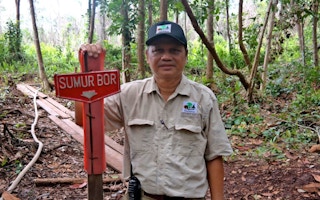The road from this inland provincial capital in southern Borneo to the delta city of Banjarmasin is littered with degraded forests and peat swamps, hallmarks of a region at the epicenter of last year’s nationwide fire and haze crisis.
Amid this arid landscape, however, lies an oasis: the peat forest of Jumpun Pambelom, whose name means “life source” in the local Dayak Ngaju language.
The jungle here is largely the work of a Ngaju man named Januminro. Since 1998, when Indonesia experienced one of the worst episodes of uncontrolled burning in recorded history, the 54-year-old has bought up and reforested degraded land in the area — a hectare here, a few there.
Today Jumpun Pambelom spans 18 hectares (44 acres) and bustles with with plant and animal life, from rare ulin trees (Eusideroxylon) and towering ramins (Gonystylus) to endangered Bornean orangutans (Pongo pygmaeus) and sun bears (Helarctos malayanus), not to mention plenty of swamp fish and game.
Januminro’s forest has also become an exemplar of fire prevention in one of Borneo island’s most vulnerable landscapes, where vast swaths of a huge wetlands system have been drained and dried for agriculture.
The area now encompassed by Jumpun Pambelom was once part of former strongman President Suharto’s failed Mega Rice Project, which aimed to convert 1 million hectares of peat bogs into rice paddies in the late 1990s.
Thousands of kilometers of drainage and irrigation channels were dug, but 1997 was an El Niño year, which meant a longer dry season, and the desiccated peat went up in flames. Smoke blanketed Southeast Asia, sparking an outcry from Indonesia’s neighbors. The Mega Rice Project was quickly abandoned, leaving a devastated ecosystem in its wake.
The steady march of oil palm and timber plantations in recent decades has turned the haze into an annual occurrence. Last year’s disaster, exacerbated by another El Niño, was in the same league as 1997-8. The 2015 fires burned an area the size of Vermont, sickened half a million people and emitted more carbon on a daily basis than the entire U.S. economy combined.
“
Hopefully this is the spirit we are contributing so that the forest can be a source of life for the surrounding community.
Januminro, Jumpun Pambelom forest restorer
President Joko Widodo reacted to the crisis by overhauling the nation’s peat policy. He banned new development on all peatlands and established an agency to restore 2 million hectares of damaged peat soil. This year the agency is focusing on four districts. One of them is Pulang Pisau, where Jumpun Pambelom is located.
Januminro and his team managed to protect Jumpun Pambelom from last year’s blaze, a remarkable feat considering that the area was hit so hard by the disaster that the air above Palangkaraya turned a noxious ochre color.
The forest is flanked by dozens of wells at intervals of 100 to 150 meters. Their function is to dampen the fire-prone areas, especially along the road nearby.
Januminro has also overseen the damming of drainage canals in the vicinity of his forest, a crucial measure if the larger peatland ecosystem is to remain wet and healthy.
Since 2010, Jumpun Pambelom has organised volunteer firefighters, part of a series of initiatives involving local communities.
“We also provide a number to call,” Januminro said. “If people see a fire can directly contact us either by SMS or phone.” Sometimes he distributes free phone credit to people in fire-prone locations.
As a result, Jumpun Pambelom was not only largely spared from last year’s fires, but it even served as a base of operations for the volunteers to fight fires outside of the forest.
Januminro’s firefighters are funded by an adopt-a-tree program. For 10,000 rupiah, one can sponsor the planting of a tree in the Jumpun Pambelom.
The seeds come from a nursery program. Local people are invited to farm seeds, which Jumpun Pambelom will buy for 2,500 each.
The forest has received some support corporate social responsibility programs, private donors, the UN Development Program and local governments. That money funded the purchase of an additional 50 hectares of land adjacent to Jumpun Pambelom which will later be reforested. It has also supported a series of fire prevention training sessions in Riau and West Kalimantan provinces involving dozens of villages.
“We teach them how to prevent fires, how to drill wellbores and how to block canals,” said Januminro, who graduated from Lambung Mangkurat University in Banjarmasin with a degree in forestry in 1986, and earned his masters in economics from the University of Palangkaraya in 2011.
Last year, Januminro received Indonesia’s prestigious Kalpataru Award from President Jokowi. He hopes his forest can be visited by many people — entry is free — and serve as an example for the country.
“Hopefully this is the spirit we are contributing so that the forest can be a source of life for the surrounding community,” he said.
This story was published with permission from Mongabay.com

















